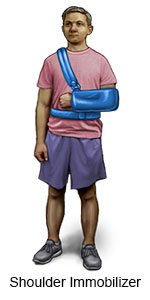Shoulder Immobilizer
Medically reviewed by Drugs.com. Last updated on Aug 4, 2025.
A shoulder immobilizer is a device used to keep your arm from moving while your shoulder heals. It is different from a sling because it keeps your arm close to your body. An immobilizer usually has a chest band, an arm band, and a wrist band. Each band will be attached to the chest band. This helps keep your arm from moving up, down, or away from your body.
 |
DISCHARGE INSTRUCTIONS:
Call your doctor if:
- Your arm, hand, or fingers become swollen, numb, painful, or pale.
- You have questions about how to use the immobilizer.
How to use a shoulder immobilizer:
Your healthcare provider will teach you how to put on your immobilizer. The following are general guidelines to help you remember what your provider teaches you:
- Place the chest band where you want it to be. Your device may have a specific part that goes on the side of the injured shoulder.
- Wrap the chest band around your body. The band should be snug but not too tight.
- Hook the wrist strap to the chest band. Wrap the wrist band around your wrist. Make sure your hand can move freely. You will need to move your hand and wiggle your fingers to prevent stiffness.
- Hook the arm band to the chest band, under your armpit. Wrap the short end of the arm band around your arm, right above the elbow. Pull the long end of the arm band behind your back. Secure it to the back of the chest band.
- Attach the shoulder strap to the front of the chest band. Attach the band on the side of your body that is not injured. The buckle should be on the front of your body.
- Take the other end of the strap up and over the shoulder that is not injured. Attach it to the chest band behind your back. Your device may have a single strap to attach. It may instead have 2 straps that need to cross your back to form an X.
- Use the buckle to adjust the shoulder strap into the correct position. Your arm will be at about a 90 degree angle in front of your body.
Follow up with your doctor or orthopedist as directed:
You may need tests to check how your arm is healing. You may need to have the immobilizer adjusted, or change to a different kind of immobilizer. If your injury has healed, you may not need to keep using the immobilizer. Write down your questions so you remember to ask them during your visits.
© Copyright Merative 2025 Information is for End User's use only and may not be sold, redistributed or otherwise used for commercial purposes.
The above information is an educational aid only. It is not intended as medical advice for individual conditions or treatments. Talk to your doctor, nurse or pharmacist before following any medical regimen to see if it is safe and effective for you.
Further information
Always consult your healthcare provider to ensure the information displayed on this page applies to your personal circumstances.
